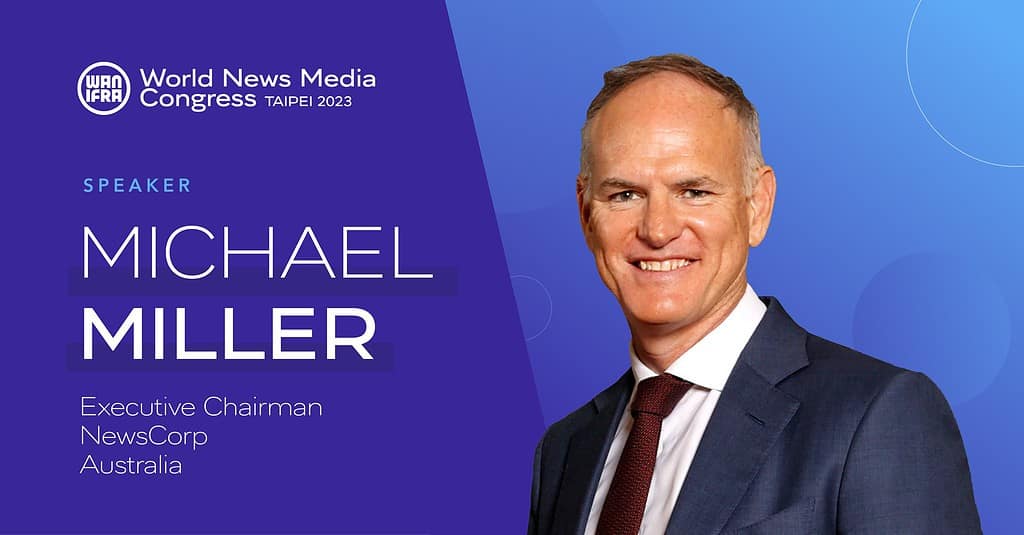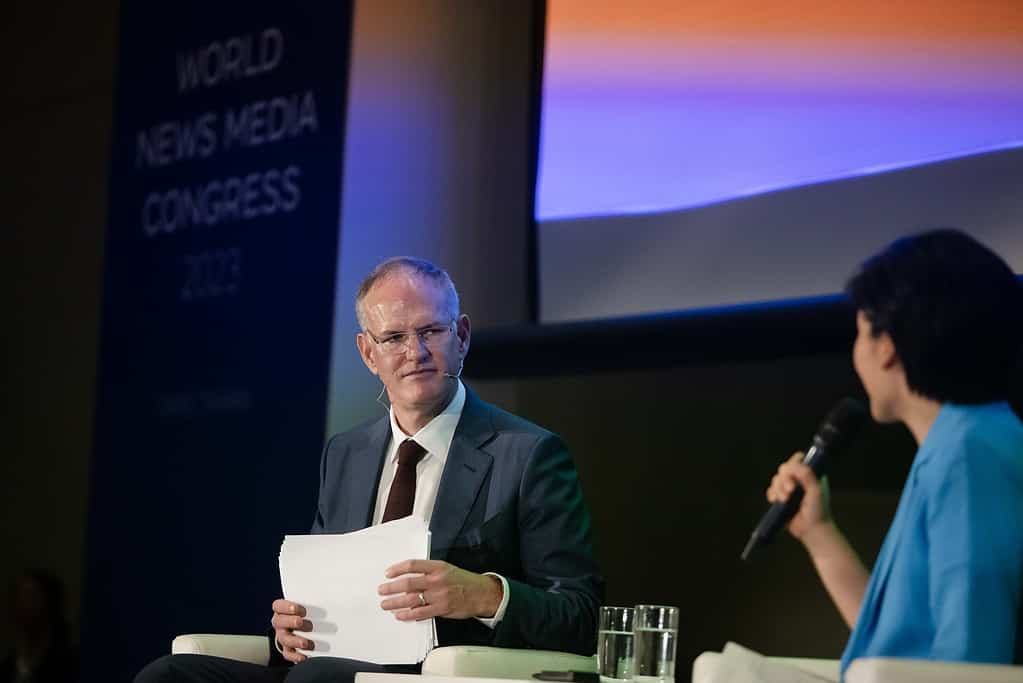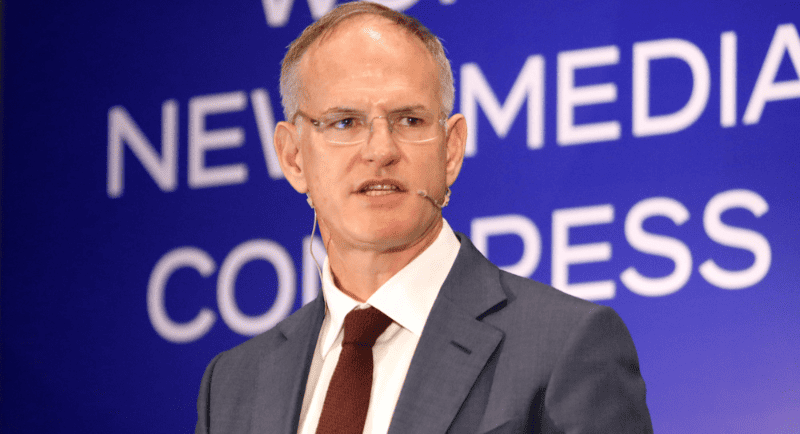News Corp Australian executive chairman Michael Miller was a guest presenter at the recent WAN IFA World News Media Congress in Taipei.
Dean Roper, director of insights and editor-in-chief of WAN-IFRA, reported on the Michael Miller session for the organisation. Below are highlights of Roper’s summary.
Michael Miller’s presentation was entitled, “Taking a stand.” Looking back some 10 years ago, Miller said most publishers “had to take a stand of a different kind.” Essentially, how to address the constant onslaught of disruption, whether that be social media, mobile phones, influencer marketing, programmatic advertising, digital marketplaces, VR, AR… on and on. And today, of course, generative AI.
“I know there isn’t a media leader here today whose business hasn’t experienced a seismic shift that changed the future course of their business over the years,” said Miller.
Despite all those challenges, Miller said that today, “the future of news media is clear – it is robust, and it is flourishing.” And his reason for this positive outlook? News Corp Australia is coming off its best financial year in a decade.
• 40 percent of the company’s total revenue now comes from digital and that digital revenue has grown 42 percent in the past two years.
• In October, the group passed the 1 million digital paid subscriber milestone, “the highest result of any publisher per capita in the world,” Miller said.
• Over the past two years, NewsCorp Australia’s total monthly audience has grown from 16.4 million to 18.1 million.
“They are turning to us in record numbers because they trust us. This is our largest audience on record.”
He credits much of this success with the “simple strategy” of better understanding NewsCorp’s audience – and the connection with that audience.

Michael Miller on News Corp’s game-changer – Verity
This is where Verity, its data analytics platform, has played a vital role. In Miller’s words, it’s “a game-changer.”
He said the publisher launched Verity in 2019, a “data assistant” for every journalist. “To change an outcome, I recommend changing the performance metrics.”
Miller demonstrated how this new way of working has shaped the group’s journalism, choosing a story about voluntary-assisted dying in the city of Adelaide. He showed how that one story generated new subscriptions, 20 times more subscriber page views vs. an average article; its journey through other NewsCorp titles, on social, and newsletters and the data gleaned from that.
For example, the existing subscribers who read the story were predominantly older females. However, new audiences came from younger and middle-aged people. A quarter of the article’s readership is in the blue-collar worker bracket, four times their proportion of the population. It highlighted what articles led subscribers to the story. Other information available to the journalists includes postcode, video, picture gallery and engagement metrics.
“I clearly remember attending an industry conference in 2010, not dissimilar to this one, when one of the editors jokingly asked … ‘Are we the last group of editors to be sacked for falling circulation, or the first group …not to be sacked?’ ”
A year later, he recalled, The Australian would be the first in the group to charge for digital subscriptions to its website. But even then, he said, circulation was still the main measurement used. “We needed to move beyond circulation and readership as the key metrics for editors and journalists.”
In 2017 the group exited the Audit Bureau of Circulations and stopped publishing newspaper sales figures altogether.
Miller said: “Journalists and editors now know what masthead success – and their own personal success – looks like in 2023.
And they are measured and rewarded for digital subscription acquisitions.
In the previous week (before Congress), Miller said, 54 percent of their 1000-plus journalists used Verity to track their performance, accessing the tool three times per day. As a group they published:
• Nearly 6,500 original articles
• Generated more than 5,000 subscriptions
• 65% of which came through social channels such as Facebook
“I know the lifetime value of each of those subscriptions is $575 AUD,” Miller said.
“Thus, over the past week we generated $2.8m in recurring consumer digital revenue.”

Subscriptions driven by hyperlocal news
He said the tool has also helped NewsCorp to see where to invest in its journalism. In this case, it revealed that 55 percent of all subscriptions are driven from hyperlocal news. This explains NewsCorp’s launch of 24 new digital mastheads dedicated to hyperlocal news over the last few years, Miller said. These are typically in regions with a population of 15,000 or more people. “They are in progressive communities with active sporting, political, business and tourism interests, and lower social media engagement.”
Thanks to its central technology and marketing resources, Miller said these titles can be manned by just one journalist. “If that single journalist can generate seven new subscriptions a week, then their salary is covered.”
He said those titles are typically profitable within two years.
News Corp data local team leans on GenAI
To supplement this local journalism, Miller said NewsCorp has a team of four staff that they call “data local” who generate 3000 articles a week using generative AI to cover daily topics such as local weather, fuel prices, and traffic conditions.
Leaning in even more so on local journalism, Miller said NewsCorp has also launched a community streaming service, KTV, which will broadcast more than 2300 national, state and local grassroots sports events and competitions. It comes included with a subscription to their local masthead.

Michael Miller speaking to WAN-IFRA delegates in Taipei
CODE and other specialist digital brands
The company has also invested in a number of other specialist digital mastheads: CODE Sport for the sports-only subscriber; Stockhead for emerging financial stocks; Racenet with wagering tips; SuperCoach for fantasy sports; Body+soul in the health category; and Taste for recipes, to name just a few.
Bundling subscriptions of these verticals has gone a long way to help NewsCorp retain existing subscribers, “as well as attracting new audiences of their own,” he said.
Campaigning journalism
For Miller, quality journalism has been the steadying force for NewsCorp and he said the publisher has “deliberately doubled down on it.” Two core themes are providing content for everyday Australians and especially those without a voice. Miller cited recent stories campaigning for more maternity wards in Brisbane or for helping to prevent suicides among military veterans. Then there are those stories that may not prove popular at times but are all about accountability – stories that build trust.
“In journalism, if you stand for nothing, you fall for everything.”
Miller pointed to Sharri Markson’s investigative work about the origin of the Covid-19 virus. Those reports claimed that Covid did originate at the Wuhan Institute of Virology.
“She and our company were condemned by the Chinese government, questioned by other media outlets, and her stories led to trade sanctions against Australian businesses. Yet just this month alleged Patient Zero was identified as Ben Hu from the Institute. Sharri’s dogged reporting led the way globally ensuring the Covid lab leak theory was properly explored.”
See also: News Corp reports new highs for Kayo and Binge, notes ‘insipid’ ad market
